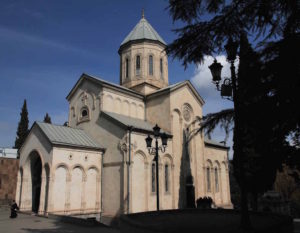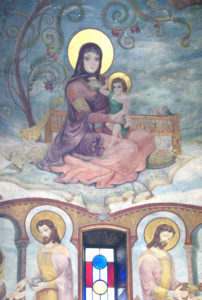 Today is Forgiveness Sunday at the Kashweti Church of St. George, a major church in downtown Tbilisi that welcomes some 300-500 parishioners through its hammered metal doors every service, with dozens more passing through every hour of the work week to pray in front of large icons of the Theotokos or snap discrete photos of the extraordinary East apse by 1930s avant-garde wall paintings by artist Lado Gudiashvili.
Today is Forgiveness Sunday at the Kashweti Church of St. George, a major church in downtown Tbilisi that welcomes some 300-500 parishioners through its hammered metal doors every service, with dozens more passing through every hour of the work week to pray in front of large icons of the Theotokos or snap discrete photos of the extraordinary East apse by 1930s avant-garde wall paintings by artist Lado Gudiashvili.
This Sunday, as the liturgy concludes, the two choirs of young male singers have a pressing matter on their minds: tomorrow Great Lent begins, and with it, the responsibilities of the choir suddenly increase. Every day this coming week, the Canon of Repentance of Andrew of Crete will be performed at special 4pm Great Compline services.
 The music for this service in the Georgian tradition requires the singing of complex polyphonic settings, with new melodies and harmonies to rehearse. During the singing of these texts, no liturgical action potentially distracts attention from the choir’s potential mistakes, rather, the entire clergy and parish meditate silently to the penitentiary texts of St. Andrew: any musical mistake will not only be immediately evident, but will distract from the prayerful atmosphere of these special services. Thus, an immediate rehearsal is called and excitement builds to sing this new repertory. Everyone in the chant community knows of its extraordinary beauty, because of a few independent examplars that are often recorded, but almost no choirs in the country sing the entire canon.
The music for this service in the Georgian tradition requires the singing of complex polyphonic settings, with new melodies and harmonies to rehearse. During the singing of these texts, no liturgical action potentially distracts attention from the choir’s potential mistakes, rather, the entire clergy and parish meditate silently to the penitentiary texts of St. Andrew: any musical mistake will not only be immediately evident, but will distract from the prayerful atmosphere of these special services. Thus, an immediate rehearsal is called and excitement builds to sing this new repertory. Everyone in the chant community knows of its extraordinary beauty, because of a few independent examplars that are often recorded, but almost no choirs in the country sing the entire canon.
VIDEO: Aghsavali Ensemble performs Uteslod midgomili hshobs (Ineffable is the childbearing), 9th heirmos of the canon of St. Andrew of Crete (March 2nd, 2017), at the Kashweti Church of St. George in Tbilisi, Georgia
We begin the rehearsal with the kondakion from the canon: “My Soul, My Soul, why are you sleeping?” one of the hymns made famous by the impeccable recordings of the Anchiskhati Church Choir in the recent Post-Soviet decades. With this melody in mind, we are ready to go through the eight heirmoi, simple and ornamented refrains, and assorted other chants. The troparia texts will be read by the deacons, we’re informed, and that’s a good thing because there are some 250 of them!
Music notation for this canon, as well as all of Great Lent and Pascha, can be found in Volume IV of Kartuli Galoba, edited by Malkhaz Erkvanidze, John Graham, et. al.
The melodies for the heirmoi texts are long and complex, the harmony voices even more ornamented. We can surmise from the written transcriptions of this music that only master chanters would have been capable of performing these difficult chants without notation of any kind. Indeed, the music was performed for transcriber Pilimon Koridze in 1885 by three choir directors from different regions of West Georgia who were brought together specifically for the purpose of recording the most unique, rare, and ornamental variants of what is collectively called “Gelati Monastery School” chant (Razhden Khundadze from Kutaisi, Dimitri Chalaganidze from Martvili, and Ivliane Tsereteli from Upper Imereti).
As we sing through one chant after another, poring over the printed notation, one can’t help but be impressed with the interweaving playfulness of the three voice parts. Where the melody singer in the top voice holds a long note, the middle voice fills in the space with a series of ornamental patterns that shift the harmony from one chord to another. The bass voice anticipates these shifts, and shifts up or down in step with both of the upper voices.
Example 1. Uteslod midgomili hshobs (Ineffable is the childbearing), musical phrasing

The most musically profound moments come at moments of textual importance: on the words ghmrtisa shoba stsvalebs… (the Lord’s birth changed…), for example, which comes in the middle of the ninth heirmos of the canon (Ineffable is the childbearing), the top voice slowly rises to hold a long note on the word “Lord” (see Example 1). At this moment, in order to sustain energy under such a long held note and to propel the chant forward, the middle voice fills the octave with a wonderful rising harmony line. Then as all three voices build an extraordinary phrase in anticipation of the musical climax on the word “changed”, the bass voice adds a layer of rhythmic complexity by syncopating its movements with the harmonic rhythm of the upper voices.
These elements show the virtuosity of a class of singers that no longer exist today, a group of master chanters able to create complex harmony in real time not by singing simple parallel harmony, or just duplicating past material, but using their gifts as improvisers perfected in the sphere of folk music to magnify the musical melody of the chant.
John A. Graham
Member of the Aghsavali Ensemble since 2009






Kerry Lee
Thank you, John, for your explanation.